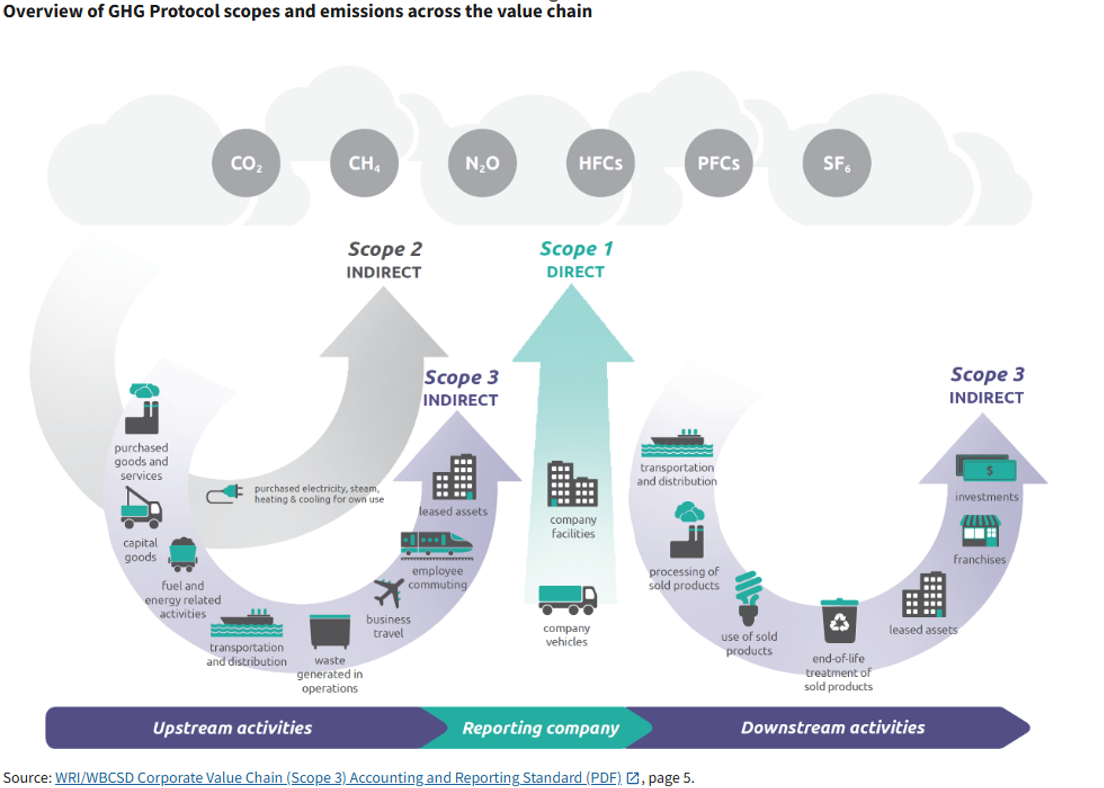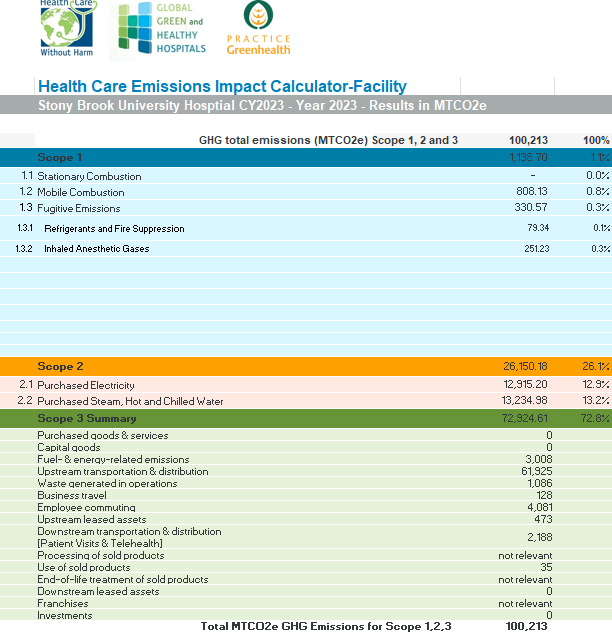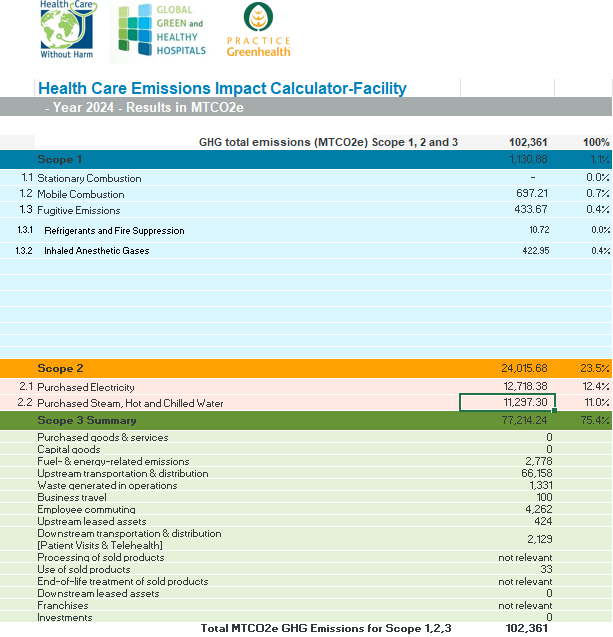Stony Brook University Hospital and the Health Sector Climate Pledge
Stony Brook University Hospital signed onto the White House/Health and Human Services Health Sector Climate Pledge in October 2022. This pledge was highlighted at the United National Climate Change Conferences (COP 27 and 28). SBUH is proud to join over 130 organizations that have joined the Health Sector Climate Pledge, committing to lowering greenhouse gas emissions and building more climate resilient infrastructure.
Specifically, Stony Brook and other pledge signers commit to:
- At minimum, reduce organizational emissions by 50% by 2030 (from a baseline no earlier than 2008) and achieve net-zero by 2050, publicly accounting for progress on this goal every year.
- Designate an executive-level lead for their work on reducing emissions by 2023 or within six months of signing the pledge and conduct an inventory of Scope 3 (supply chain) emissions by the end of 2024.
- Develop and release a climate resilience plan for continuous operations by the end of 2023 or within six months of signing the pledge, anticipating the needs of groups in their community that experience disproportionate risk of climate-related harm.
This page will provide updates on progress as we work towards these bold goals.
The executive level lead for this pledge is Carol Gomes, Chief Executive Officer.
Stony Brook University Hospital’s SBUH Climate Resilience Plan December 2025 for continuous operations has been developed.
Stony Brook University Hospital has begun to estimate Scope 1, 2, and 3 Greenhouse Gas Emissions.
Greenhouse gases are gases that trap heat in the atmosphere. Greenhouse gas emission are composed of many different chemicals including carbon dioxide, methane, oxides of nitrogen, and fluorinated gases. They are generally expressed as a group with respect to their environmental impact as carbon dioxide equivalents (CO2e).
Stony Brook University Hospital has begun to estimate the greenhouse gas emissions, caused directly or indirectly by their operations. Each year, data collection is improved, and the estimates are refined. To date SBUH has estimated all Scope 1 and Scope 2 GHG emissions, and Scope 3 emissions in categories 3 through 15. We will continue to work on the remaining Scope 3 categories.

Scope 1 GHG emissions are associated with sources under the control of the organization (for example, emissions from an onsite boiler). Scope 2 emissions are indirect GHG emissions that are associated with the purchase of electricity, high-temp hot water, and chilled water. Scope 3 emissions are sometimes called value chain emissions and are emissions associated with activities from assets not owned or controlled by the organization, but which affects its value chain. Examples of Scope 3 emissions include employee travel and commuting, the emissions from purchased goods and services. They reflect both upstream and downstream activities associated with the organization. There are fifteen categories of Scope 3 emissions, although some of them are not relevant to a given organization.
More information can be found from the Environmental Protection Agency.
Stony Brook University Hospital is estimating GHG emissions using the GHG emissions calculator developed for hospitals by Practice Greenhealth and Healthcare Without Harm. In Scope 3 emissions, SBUH has determined that categories 10 (processing of sold products), category 12 (end-of-life treatment of sold products) and category 14 (franchises) are not relevant. This is typical of most hospitals. Additionally, SBUH does not estimate emissions from category 15, investments. The calculations of category 1 (purchased goods and services) and 2 (capital goods) have not yet been completed. Efforts continue to make those calculations and to refine data across the entire GHG calculations.
Our current estimates of GHG emissions from CY 2023 and 2024 follow:


Climate Protector Policy Statement, 2023
Stony Brook University Hospital, consistent with our shared core values and our intent to achieve excellence, remains dedicated to supporting healthier and more resilient communities, both locally and globally. We recognize that climate change directly impacts the health of our patients and our communities, and strive to minimize the environmental impact of our operations. We recognize our responsibility to provide leadership in these areas.
We accept the critical link between human health and the health of the environment and continue to seek new and innovative ways to improve environmental performance through conservation, purchasing, reduction, re-use and recycling programs.
SBUH applies these principles to achieve optimal environmental standards consistent with our mission to deliver world-class, compassionate care to our patients, advance our understanding of the origins of human health and disease, and educate the healthcare professionals and biomedical investigators of the future, so they can bring the fruits of scientific discovery to our patients.
In an effort to respect and protect the earth's resources, restore environmental quality, and protect human health SBUH
- Instills environmental responsibility within the I-CARE organizational values.
- Sets annual goals and develops action plans to continuously improve the quality and measurable outcomes of our environmental programs.
- Monitors, evaluates, and reports practices as they relate to these environmental principles.
Additionally in October 2022, SBUH signed onto the Healthcare and Human Services' Health Care Sector Climate pledge (announced at the United Nations Climate Change Conference, COP 27) which requires that SBUH:
- At minimum, reduce organizational emissions by 50% by 2030 (from a baseline no earlier than 2008) and achieve net-zero by 2050, publicly accounting for progress on this goal every year.
- Designate an executive-level lead for their work on reducing emissions by 2023 and conduct an inventory of Scope 3 (supply chain) emissions by the end of 2024.
- Develop and release a climate resilience plan for continuous operations by the end of 2023, anticipating the needs of groups in their community that experience disproportionate risk of climate-related harm.
We are invigorated in our efforts to meet these bold goals.
Carol Gomes, MS, FACHE, CPHQ
Chief Executive Officer & Chief Operating Officer, Stony Brook University Hospital
February 1 2023
Environmental Policy Statement 2018 –
Stony Brook University Hospital is committed to promote healthier communities both locally and globally, and to be an environmental leader in all aspects of our buildings and operations in a manner that demonstrates protection of the environment and human health.
We recognize the critical link between human health and the health of the environment, and continue to seek new and innovative ways to improve environmental performance through conservation, purchasing, reduction, re-use and recycling programs.
SBUH applies these principles to achieve optimal environmental standards consistent with our mission to deliver world-class, compassionate care to our patients, advance our understanding of the origins of human health and disease, and educate the healthcare professionals and biomedical investigators of the future, so they can bring the fruits of scientific discovery to our patients.
In an effort to respect and protect the Earth’s resources, restore environmental quality and protect human health, SBUH will:
- Instill environmental responsibility as a corporate value
- Set annual goals and develop action plans to continuously improve the quality and measurable outcomes of our environmental programs
- Monitor, evaluate and report our practices as they relate to these environmental principles.
DEHP/PVC Free Pledge –
Stony Brook University Hospital is committed to the health of our patients, our staff and our communities. We are committed to the reduction of di(2-ethylhexyl)phthalate (DEHP) and polyvinyl chloride (PVC), in our Neonatal Intensive Care Unit (NICU) and our hospital. Specifically, we are committed to the following measures to make our NICU, and our institution, a model of environmental responsibility, by reducing the use of DEHP-containing and PVC-containing products. We pledge to:
- Conduct a PVC/DEHP audit to identify uses and sources of DEHP/PVC in our medical devices.
- Continue to regularly monitor the availability of safe and effective alternatives to reduce the amount of DEHP- and PVC-containing products.
- Commit to eliminating, where possible, the use of PVC- / DEHP-containing products.
- Communicate the commitment to PVC- /DEHP-free purchasing to contractors and vendors, and include language in our contracts and request for proposals (RFPs) that express our commitment to minimize the use of PVC and DEHP in our institution.
- Collaborate hospital-wide to urge support for implementation of PVC and DEHP reduction measures.

